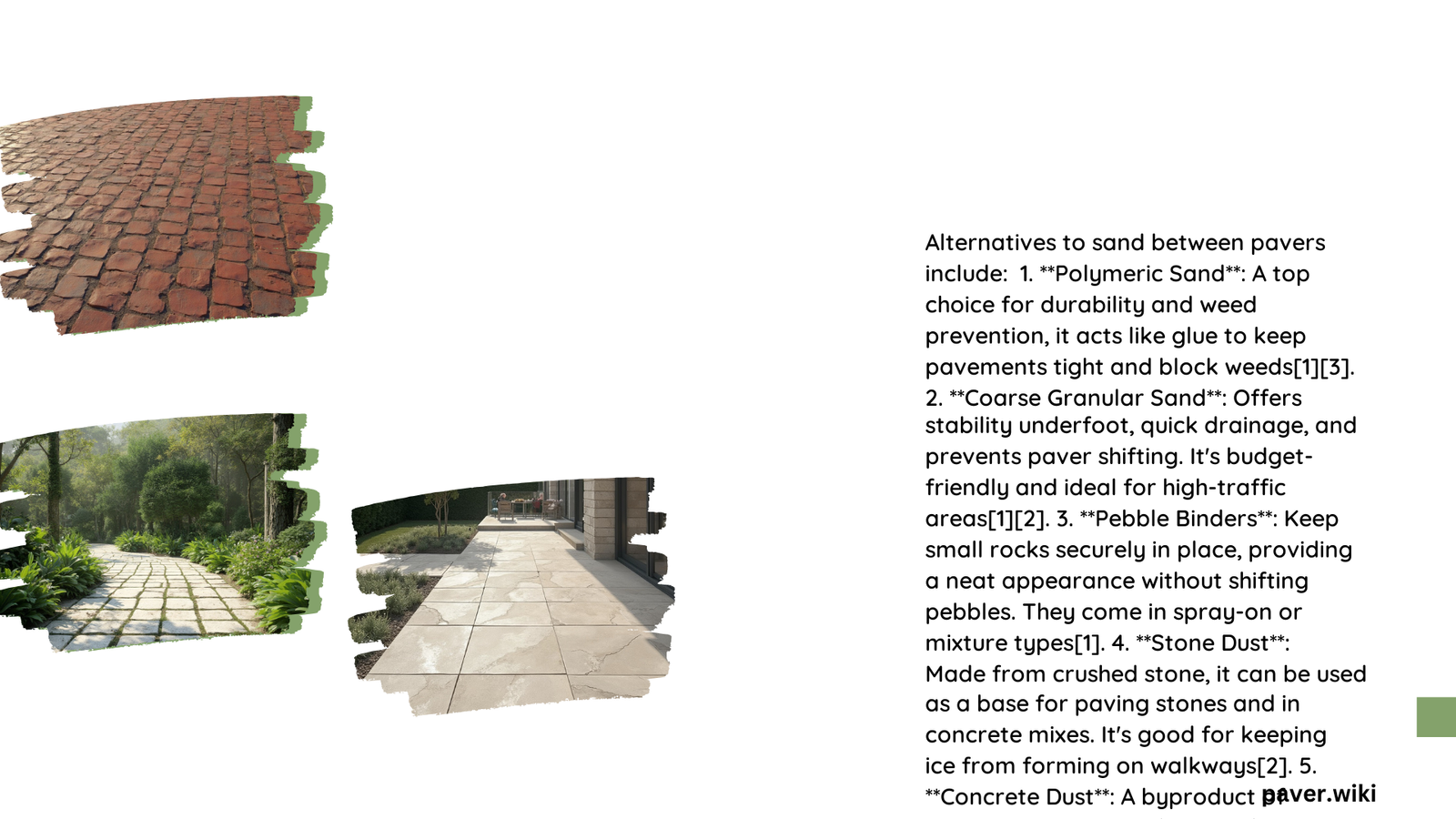When it comes to paver installation, the material used between the joints plays a crucial role in stability and longevity. While traditional sand has been a common choice, alternatives to sand between pavers offer improved durability, weed resistance, and aesthetic appeal. This article explores various options, their specifications, costs, and performance metrics to help you make an informed decision for your paving project.
What Are the Main Alternatives to Sand Between Pavers?
The primary alternatives to traditional sand for paver joints include:
- Polymeric Jointing Sand
- Mason Sand (or Concrete Sand)
- Gravel
- Crushed Stone
- Silica Sand Alternatives
Each of these options has unique properties that make them suitable for different paving applications. Let’s delve deeper into each alternative.
How Does Polymeric Jointing Sand Compare to Traditional Sand?

Polymeric jointing sand is a popular alternative that offers several advantages over traditional sand:
- Composition: It consists of fine sand mixed with polymers and binding agents.
- Stability: Once activated with water, it hardens to create a solid bond between pavers.
- Weed Resistance: Forms an almost airtight seal, preventing weed growth.
- Durability: Highly resistant to erosion from rain and traffic.
However, it’s important to note that polymeric sand is not suitable for permeable joints and is more expensive than traditional sand options.
What Are the Benefits of Using Mason or Concrete Sand?
Mason sand and concrete sand are two variations of sand that offer different benefits:
Mason Sand:
- Finer particles than concrete sand
- Packs tightly, reducing the likelihood of washing away
- Good for narrow joints
Concrete Sand:
- Larger particles than mason sand
- Provides better water drainage
- Suitable for wider joints
Both options are more affordable than polymeric sand but may require more frequent replenishment.
Can Gravel or Crushed Stone Be Used Between Pavers?
While gravel and crushed stone are excellent base materials for paver installations, they are not typically recommended for filling joints between pavers. Here’s why:
- Size: The particles are too large for most paver joints.
- Stability: They don’t provide the same level of stability as sand or polymeric sand.
- Shifting: Prone to shifting, which can lead to uneven surfaces.
These materials are better suited for use as a base layer beneath the pavers rather than for joint filling.
What Are the Installation Techniques for Different Paver Joint Materials?
The installation process varies depending on the material used:
Polymeric Jointing Sand:
- Sweep dry sand into joints
- Compact the surface
- Activate with water
- Allow to dry completely
Mason or Concrete Sand:
- Spread sand over the paver surface
- Sweep into joints
- Compact the surface
- Add more sand as needed to fill settling
Gravel or Crushed Stone (for base layer):
- Spread evenly as a base layer
- Compact thoroughly before laying pavers
How Do Costs and Quantities Compare Among Paver Joint Alternatives?
Here’s a comparative breakdown of costs and quantities for different paver joint materials:
| Material | Relative Cost | Typical Coverage |
|---|---|---|
| Polymeric Sand | Higher | 25 lb bag covers ~50-100 sq ft |
| Mason Sand | Lower | Varies by joint width |
| Concrete Sand | Lower | Varies by joint width |
| Gravel (base) | Lowest | Not for joint filling |
| Crushed Stone (base) | Lowest | Not for joint filling |
Actual costs and quantities will depend on your specific project requirements and local material prices.
What Are the Long-Term Effects of Different Paver Joint Materials?
The choice of joint material can have significant long-term impacts on your paver installation:
Polymeric Sand:
- Minimal maintenance required
- Long-lasting stability
- Excellent weed and insect resistance
Traditional Sand (Mason or Concrete):
- May require periodic replenishment
- Can settle over time
- Moderate weed resistance
Gravel or Crushed Stone (as base material):
- Provides excellent drainage
- Stable base for pavers
- Not suitable for joint filling
How Does Water Drainage Efficiency Vary Among Paver Joint Options?
Water drainage is a crucial factor in paver installations. Here’s how different materials perform:
- Polymeric Sand: Good drainage, but not permeable
- Mason Sand: Moderate drainage
- Concrete Sand: Better drainage than mason sand
- Gravel/Crushed Stone: Excellent drainage (when used as base)
For areas requiring high permeability, specialized permeable paver systems may be more appropriate.
What Maintenance Is Required for Different Paver Joint Materials?
Maintenance requirements vary based on the joint material used:
Polymeric Sand:
- Occasional sweeping to remove debris
- Rarely needs replacement
Traditional Sand:
- Regular sweeping and replenishment
- May need to be brushed out of joints periodically
Gravel/Crushed Stone (base):
- Minimal maintenance when used as a base layer
Proper installation and choice of material can significantly reduce long-term maintenance needs.
By considering these alternatives to sand between pavers, you can choose the option that best suits your specific needs, budget, and long-term maintenance preferences. Each material offers unique benefits, and the right choice will depend on factors such as climate, paver type, and intended use of the paved area.
References:
1. Keep It Clean Florida – What Kind of Sand is Best for My Pavers?
2. Western Interlock – Paver Joint Options: The Best Products to Lock Pavers Together
3. Groupe Bellemare – Guide: Choosing the Perfect Paving Sand
